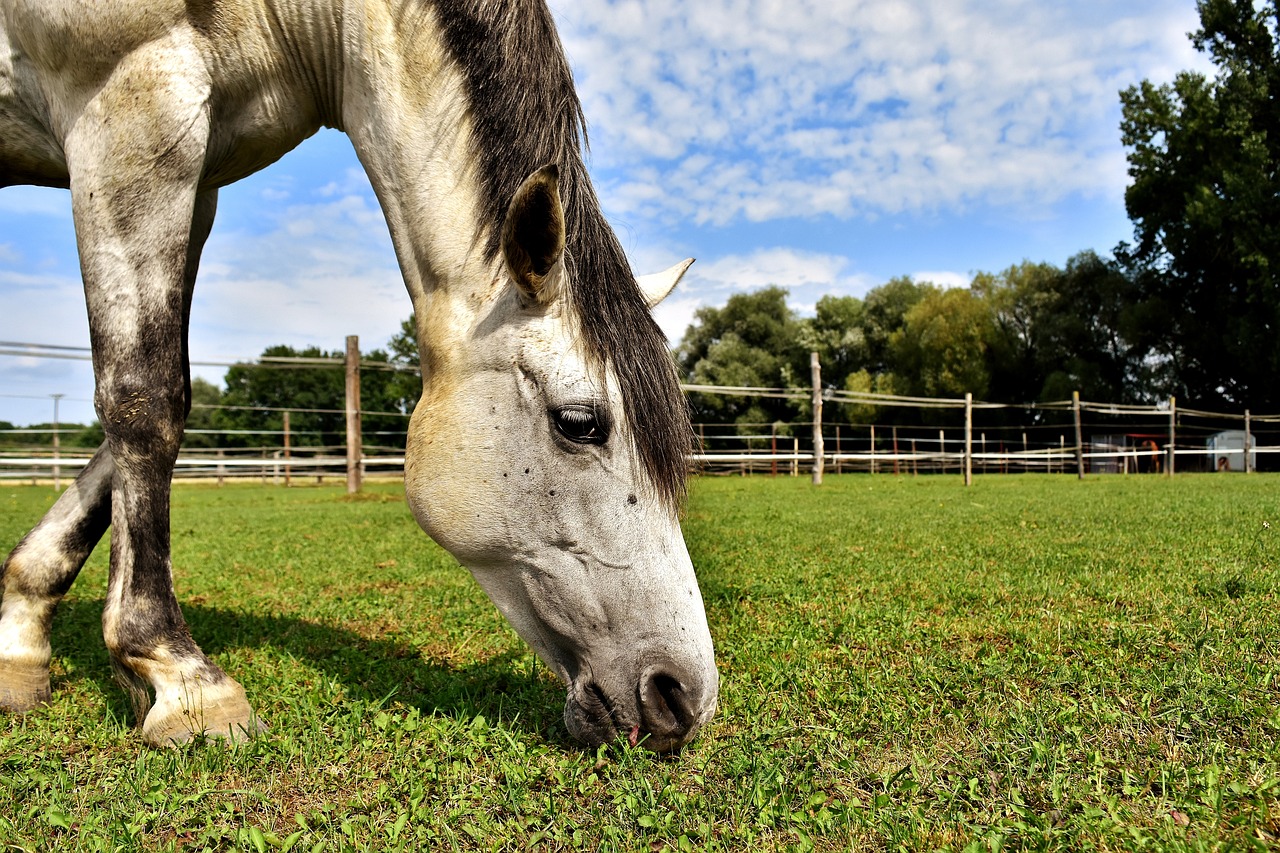Forages are a vital part of your horse’s diet. These animals were meant to spend their days roaming and grazing on different forage plants to make up a primary portion of their diet. To meet their nutritional needs, they should consume at least one to two percent of their body weight in high-quality forages daily.
Whether pasturing your animals or feeding them hay, it’s essential to understand what to look for in a forage crop and choose an ideal, high-quality species.
Benefits of Allowing Horses to Forage
There are many benefits to letting your horse(s) out of the stall or barn to graze in the pasture as often as possible.
Lessened Stomach Troubles
One of the most important benefits of putting horses out to pasture and allowing them to graze continuously on forages is the reduction of ulcers and other gut problems.
Horses are naturally grazing animals, and in turn, their stomachs constantly produce acid to aid in the digestion of the forages they were meant to graze on continuously throughout the day. In a natural setting, where the horse is chewing and eating all day, the stomach acid is buffered by saliva and forage, preventing it from damaging the animal’s stomach lining.
When your horse is fed larger, infrequent meals (i.e., grain-based) or isn’t allowed to graze throughout the day, his stomach sits empty. Gastric acid continues to be produced and builds up to the point where it can eat through the unprotected upper lining of the stomach, creating painful ulcers. Once these ulcers form, you’ll often see weight loss and poor performance overall in your animal.
Hence, your horse(s) needs access to forage as much as possible.
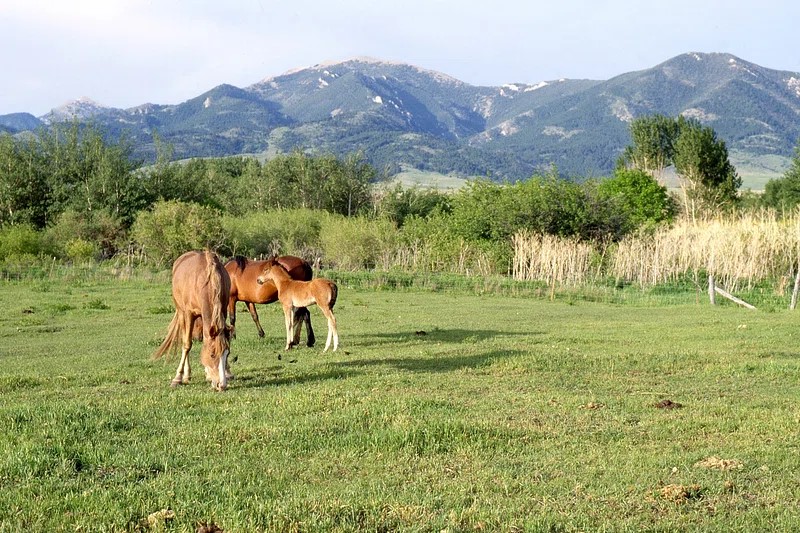
Improved Mental Health
When horses are allowed to graze, you’ll also see reduced unwanted behaviors and better mental health. They will stop eating bedding and manure, you may see improvement in cribbing tendencies, and they’ll stop chewing on the wood in the barn or their stalls.
Reduced Feed Costs
Lastly, we can’t ignore the economic benefit of letting your horses out to graze. There’s no denying that one of the most significant financial aspects of owning large animals is the associated feed costs.
Any time you allow your horse out on pasture, you reduce your spending on supplemental feed. A well-managed pasture is an economical forage source that can meet or even exceed the dietary requirements of many horses.
Qualities to Look for When Choosing a Forage
Nutritional Value
When high-quality forages are grown and well managed, they can make up most of, if not the entire diet. Because of this, it’s critical to choose a forage (or a mix of forages) that meets the nutritional needs of your animals.
Forage Yield & Consistent Growth
Beyond nutrition, you also want to choose forages with good dry matter yields and consistent, persistent growth habits. High-yielding plants are crucial to producing enough feed for your horses, and efficient growth keeps your pasture productive.
Horses are selective grazers. They’ll gravitate towards the plants they prefer, and because of their lips and tongue anatomy, they can graze plants to a considerably shorter height than other types of livestock. So you’ll need plants that can withstand this grazing and regularly regrow.
 Photo Credit: VademVasenin | depositphotos
Photo Credit: VademVasenin | depositphotos
Ideal Forages For Horses
There are several forages available that make great horse pastures. When choosing the best option(s) for your animal(s), always consider what is best adapted for your local area, climate, and management situation.
Cool-Season Grasses
Cool-season grasses make excellent forages for pasture because they grow abundantly in spring and fall when temperatures are cooler. They also tend to retain forage quality better than warm-season types.
- Kentucky bluegrass is a good turfgrass for grazing because it is low-growing and forms a tight sod that provides sound footing for your horses. Forage Kentucky bluegrass is also very palatable, highly nutritious, and tolerant of frequent, close grazing—it grows taller and leafier than varieties used for home lawns.
- Perennial, annual, and intermediate ryegrasses are highly nutritious and recover rapidly from frequent, close grazing. All ryegrasses establish quickly and are tolerant of rocky or poor soils. Perennial types are better for cooler, northern climates; annual ryegrasses are not cold-tolerant.
- Endophyte-free tall fescue has excellent fall productivity to extend the grazing season and is moderately tolerant of continuous horse grazing. Tall fescue is also good at resisting weeds, insects, and diseases. Avoid varieties with endophytes and stick with ones bred to be endophyte-free (Fawn Tall Fescue, Cajun II, Kentucky 32.)
- Orchardgrass is a highly productive forage option. It’s clean and sweet-smelling, with excellent palatability. Building an appropriate ration with orchard grass as a foundation forage is easy. Deer Creek Seed’s Amplify Brand Orchardgrass has moderate winter hardiness and grows quickly.
- Timothy grass is full of fiber—which is excellent for equine gut health—and also has a balanced ratio of calcium and phosphorus, helping to maintain bone health. It produces abundant leaves in midsummer when other forages slow their growth due to the heat.
- Small grains such as wheat, rye, oats, and barley are often used as cool-season forages in horse pastures. They’re commonly sod-seeded into dormant warm-season grass pastures to extend the grazing season.
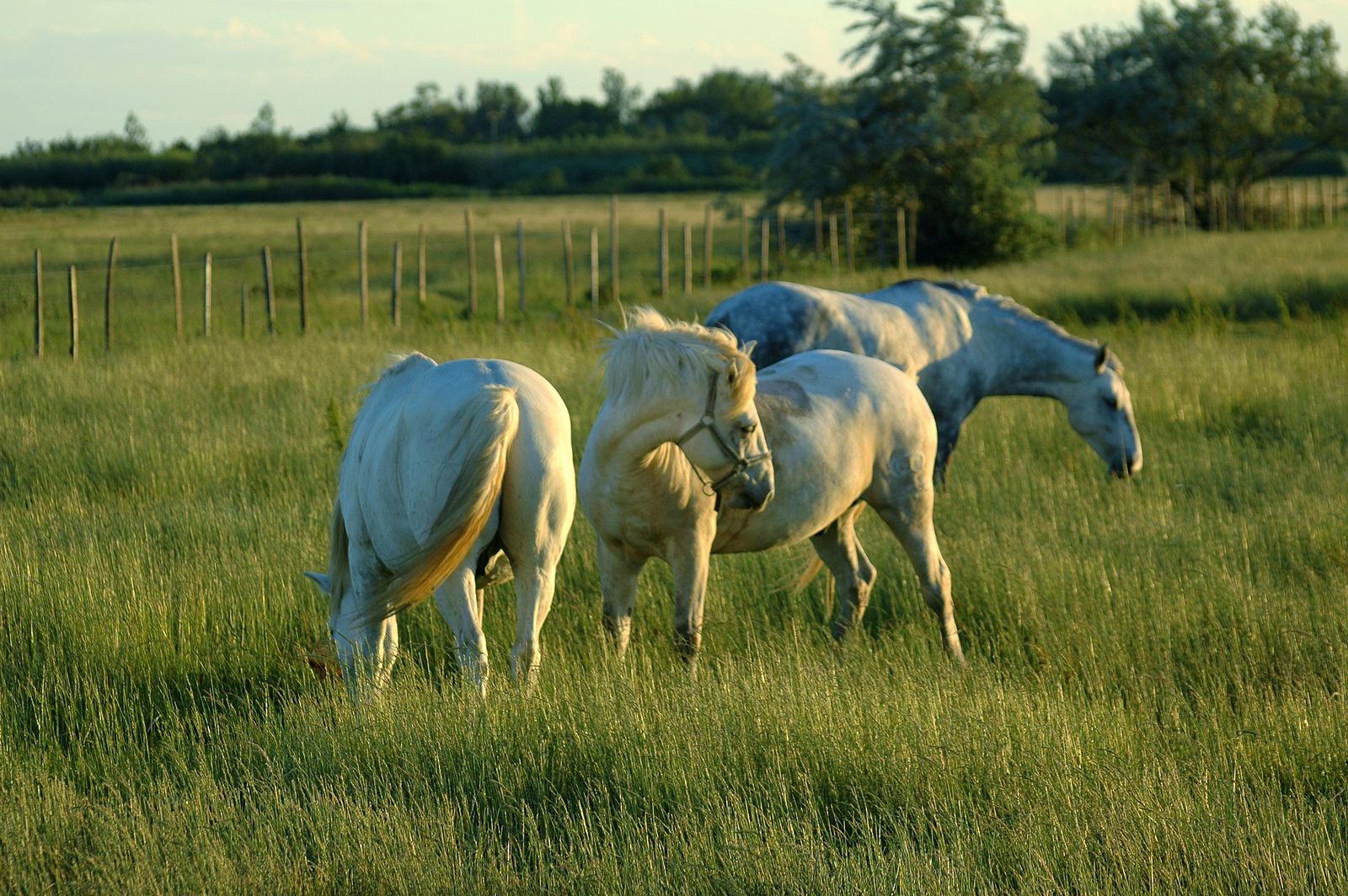 Photo Credit: Wikimedia Commons
Photo Credit: Wikimedia Commons
Warm-Season Grasses
Warm-season grasses are valuable forages for pastures, especially in Northern regions. They can provide green grazing during the summer slump when cool-season grass growth slows. These grasses generally have higher fiber content and lower crude protein and nonstructural carbohydrates than cool-season grasses.
- Bermudagrass produces large amounts of dry matter and can offer high nutritive value for your animals. It tolerates grazing pressure, and its crude protein content responds well to nitrogen fertilizer applications. Some cold-hardy forage varieties that establish well from seed are available.
- Teff grass is often recommended for overweight horses, animals with metabolic disorders, or those prone to laminitis. Compared to cool-season grasses and legumes, it has lower nonstructural carbohydrates, digestible energy, and amino acids but higher fiber values. It could also be helpful for grazing during the summer slump frequently seen in cool-season pastures.
- Old World bluestem is more sensitive to overgrazing than other warm-season types but produces large amounts of dry matter with excellent nutritional value when adequately managed. Caucasian bluestem is the forage variety of choice; it grows well in finely textured or clay soils.
- Weeping lovegrass is highly drought tolerant, making it a good choice for sandy or sandy loam soils. It greens up earlier than other grasses to provide early-season forage and works well on slopes or erosion-prone areas.
- Crabgrass has a deep-seated reputation as a nuisance weed, but this high-quality, palatable plant makes an excellent forage for horses and other livestock. Especially during the hot, dry months when other forages hit that summer growth slump. It is typically higher in nutritive value and digestibility than other warm-season grasses, including Bermuda and Old World bluestems.
Legumes
Legumes make excellent forage choices for lactating mares, growing horses, and horses in heavy work because of their higher energy and nutrient content. However, they may not be appropriate as monostands for overweight horses or those prone to certain metabolic conditions.
- Alfalfa, white clover, red clover, and lespedeza make excellent horse forage choices. They’re higher in protein, fiber (essential for digestive health), calcium, and carotene than grasses. Keep clover leaves below 35 or 40% of the forage mix to minimize slobbering.
Forages to Avoid With Horses
- Forage sorghums and sudangrasses are generally not used for horses because of cystitis, a urinary tract disorder that occurs under grazed conditions. Members of the Sorghum genus may also contain prussic acid, which can cause urinary tract problems, muscle weakness, neural degeneration, and death.
- Kleingrass is not recommended as it triggers the severe skin condition secondary (hepatogenous) photosensitization. Kleingrass contains photodynamic agents that cause a reaction in the body, resulting in ultra-sensitive skin.
- Unlike the well-loved red and white clovers, avoid grazing your horses on alsike clover, especially pure stands. It is known to cause photosensitization and big liver syndrome. Photosensitization occurs from short-term exposure and often looks like sunburn; long-term exposure may result in big liver syndrome and, ultimately, liver failure.
Forages to Feed in Moderation
- Birdsfoot trefoil contains bitter tannins, which will cause some horses to avoid grazing on it. Some varieties may also trigger colic or mild gastrointestinal discomfort in sensitive animals. The problems may be due to the high tannin content, Fusarium contamination, or prussic acid accumulation.
Are Forage Grasses or Legumes Better for Horses?
Pros of Forage Grasses
✓ High fiber content
✓ Long growing season
✓ Tolerant of frequent, close grazing
✓ Stands establish quickly
✓ Tolerant of a broader range of soils
✓ Better drought tolerance than legumes
✓ Can be grazed or used for hay
Cons of Forage Grasses
✗ Lower crude protein content
✗ Less trampling tolerance
✗ Lower dry matter yields
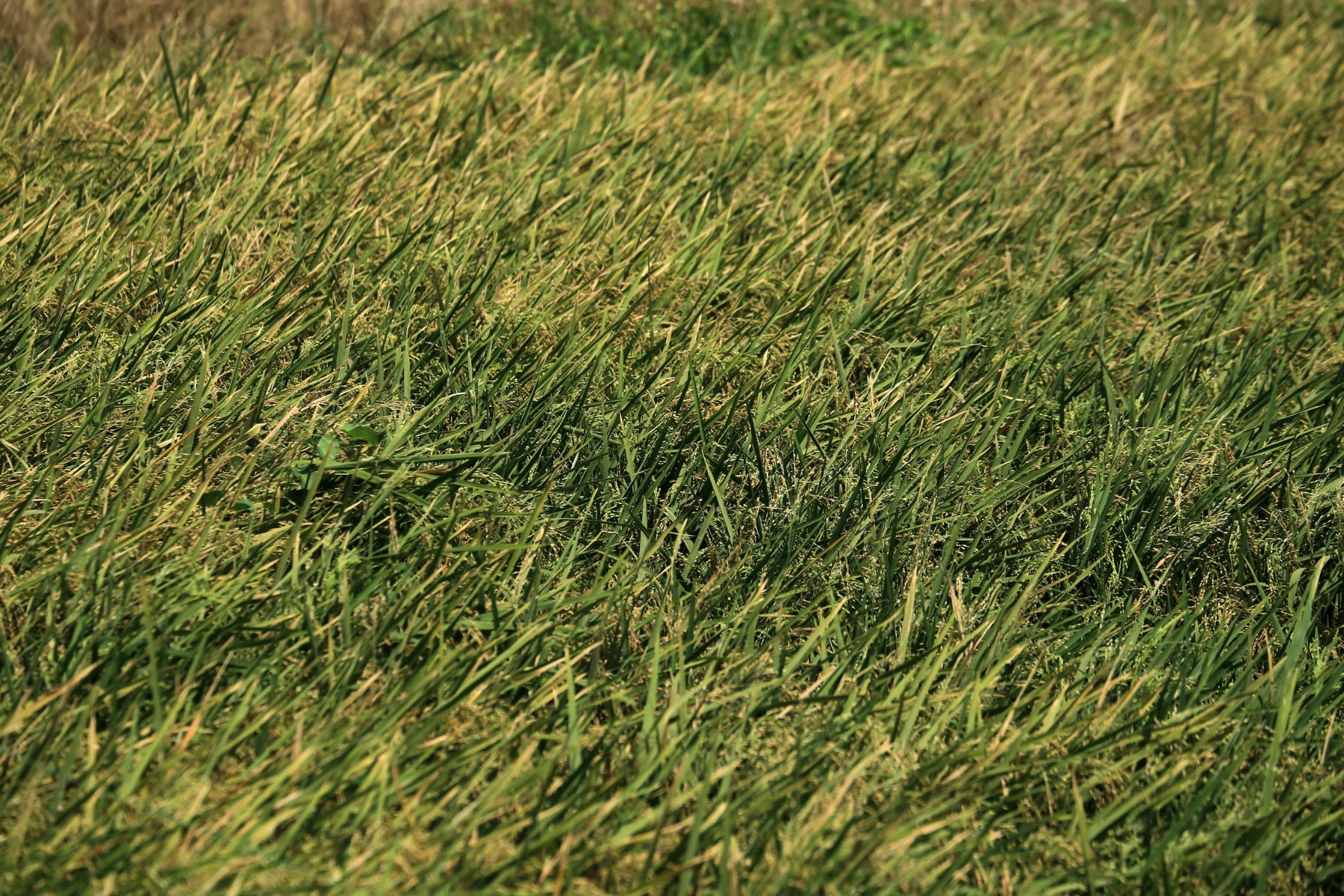 Photo Source: Jeffrey Surianto | Pexels
Photo Source: Jeffrey Surianto | Pexels
Pros of Forage Legumes
✓ High in crude protein
✓ Higher tolerance of large animal grazing
✓ Nitrogen fixation improves soil fertility and lowers fertilizer costs
✓ Improved palatability and digestibility
✓ Useful for grazing or hay
Cons of Forage Legumes
✗ Less tolerant of weather extremes (heat, cold, drought)
✗ Higher management needs
 Photo Source: Wikimedia Commons
Photo Source: Wikimedia Commons
Growing Mixed Species Pastures
There are advantages and drawbacks to growing monotstands of grasses and legumes. Since they both offer excellent forage potential, it’s hard to say that one is better than the other.
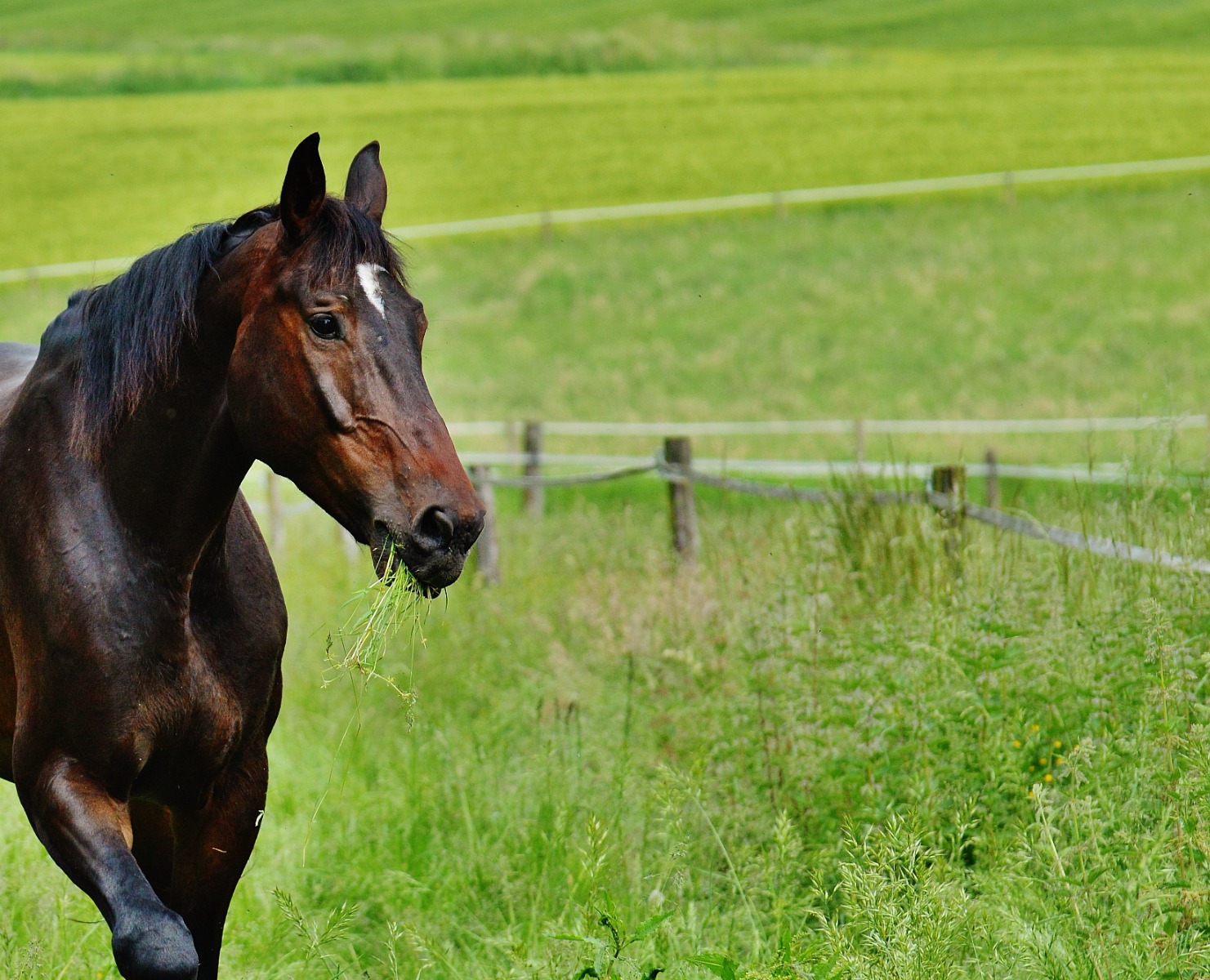
Because of this, many producers opt to plant mixed forage pastures that include multiple grass or legume species, or legumes and grasses to reap more benefits, including:
- Increased dry matter weight and crop yield
- Reduced weed competition
- Improved distribution of forage growth through the season
- Greater adaptability to weather conditions
- Reduced nitrogen fertilizer needs from the leguminous nitrogen-fixation
Looking for high-quality pasture mixtures? Deer Creek Seed offers the following selections that are great for horses.
- Equine “Endophyte-Free” Pasture Mix
- Equine Pure Grass Pasture Mix
- Pastureland Equine South
- Pastureland Over-Seeder South
- Premium Grass Base Forage Mix
If you opt to try your hand at a grass-legume pasture mix, try to keep it simple: two grass species and one legume is a fantastic starting point.
Forage Quality Analysis
There are three principal quality parameters commonly used when evaluating forages, whether pasture, hay, or silage: crude protein (CP), neutral detergent fiber (NDF), and acid detergent fiber (ADF).
For horses that rely on forages for a large part of their diet, parameters such as total digestible nutrients (TDN), net energies, non-structural carbohydrates, and mineral concentrations are also frequently reported.
Understanding Crude Protein (CP)
Protein is a vital component of forages. It is the source of energy in feed and provides nitrogen and essential amino acids to the animal.
Forages and other feeds are analyzed for crude protein (CP), the combined percentage of true protein and non-protein nitrogen. This number tells a forage’s ability to meet your horse’s protein needs and is useful when developing a ration of your livestock.
- Legume forages have 20 to 24% CP.
- Spring and summer grass pastures contain upwards of 20% CP.
Understanding Fiber Content: Neutral Detergent Fiber (NDF) & Acid Detergent Fiber (ADF)
Another critical measure of a forage’s quality is the amount of fiber in the plant material, as fiber is the predominant factor in forage digestibility. Structural components like cellulose, hemicellulose, and lignin are included in the fiber content.
Generally speaking, fiber levels and digestibility are inversely correlated. Lower fiber means higher digestibility; higher fiber means lower digestibility.
Higher digestibility typically means higher energy value for the animal and better forage quality. Low fiber values also mean the forage is easier to chew and considered more palatable (i.e., horses will consume more.)
Neutral detergent fiber (NDF) and acid detergent fiber (ADF) are used to measure a forage’s cell wall composition.
- NDF measures hemicellulose, cellulose, and lignin levels and is typically used to predict intake potential.
- In grasses, NDF < 50% is considered high quality; NDF > 60% is low.
- In legumes, NDF < 40% is considered good quality; NDF > 50% is considered poor.
- ADF measures cellulose and lignin and is commonly used to calculate digestibility.
- Forages with less than 35% ADF are typically considered high-quality.
Grasses typically contain more NDF and ADF than legumes because of greater lignification. However, you see a wide variability of NDF and ADF within grass species. And the hemicellulose, cellulose, and lignin amounts typically increase in all forages as they mature.
Understanding Moisture and Dry Matter (DM)
Dry matter (DM) is the non-moisture portion of a forage; it indicates the nutrient concentration available to your animals. The higher the dry matter, the higher the nutrients.
- Pastures typically contain 75 to 90% moisture content or 10-25% DM, regardless of the forage type.
Understanding Total Digestible Nutrients (TDN)
Total digestible nutrients (TDN) is an estimate of the energy content of a food source and is helpful for horse rations that are primarily forage. It is the sum of the digestible fiber, protein, carbohydrates, and lipids that supply energy to the animal.
TDN is directly correlated to digestible energy and is often determined using CP and ADF values.
- Low quality usually contains 45 - 52% TDN
- Mid-quality usually contains 52% - 58% TDN
- High quality usually contains greater than or equal to 58% TDN
Understanding Energy Content
The energy content of a forage can get tricky when you dive into it. At the fundamental level, the energy content of a forage (or other feed source) is the energy available to an animal that can be used for activities like growth, breathing, lactation, etc.
However, there are different ways to express energy content and some controversy surrounding this aspect of forage quality analysis.
- Gross energy (GE) is the total energy content of a forage. Not all gross energy is usable by an animal because of digestion and metabolism.
- Digestible energy (DE) is the energy of a forage absorbed by a horse, accounting for the energy lost in feces during digestion.
- Metabolizable energy (ME) is the energy left after accounting for the energy lost during digestion from the production of urine and gases. It’s the energy available for maintenance, growth, and production.
- Net energy (NE) represents the energy utilized by the horse’s body for maintenance, growth, and production. It’s calculated by subtracting all energies lost to metabolic processes from the metabolizable energy.
In America, the energy content of a forage is usually expressed as digestible energy (DE) and is reported in megacalories per pound (Mcal/lb). A forage's crude protein and ADF content provide a reasonable estimation of the DE.
However, DE is considered quite archaic because there are significant differences in how digested energy is utilized from different forages and across livestock species. Keep this in mind and view DE values as an estimate.
Understanding Non-Structural Carbohydrates (NSC)
A forage's non-structural carbohydrate (NSC) concentration is the measurement of the starch, sugar, and fructan concentration. It isn’t always analyzed for, but it is helpful if you have horses with metabolic issues like insulin dysregulation or glycogen storage diseases.
- If your horse requires a forage with limited starch and sugar, you want the NSC between or under 10 to 12%.
Understanding Mineral Content
The mineral content in any plant directly reflects the soil it grew in and fertilizer management. Total mineral content is reported as “ash” on a forage analysis. Macronutrient concentrations of the macronutrients are expressed as percentages (%) or grams per pound; trace mineral concentrations are expressed as parts per million (ppm) or milligrams per pound.
All minerals reported on a forage analysis are essential nutrients necessary for overall health. They must be in adequate quantities in your horse’s diet to satisfy daily requirements. It’s also necessary that some nutrients occur in balance with others.
- Calcium and phosphorus should be in a 2:1 ratio of approximately two parts calcium to one part phosphorus.
- Zinc and copper should have a 4:1 balance, with more zinc in the plant than copper.
- Iron levels should be no higher than 500 ppm; excess iron can inhibit the absorption of other nutrients and, in extreme cases, trigger insulin resistance. Legumes tend to have higher iron levels than grass forages.
Physical Assessment of Forage Hays
When choosing hay to feed your horses, a visual inspection of the quality is as important as its chemical analysis. You’ll want to look at color, smell, maturity, leafiness, and foreign matter.
Color
Color is obviously one of the first things you look at when inspecting forage. You preferably want the hay to be green, which indicates good nutrient content, but it should not be the primary or only focus. Remember that weeds also stay green when they’re dried.
Light or pale yellow on the outside of a bale indicates sun-bleaching. This isn’t necessarily bad as long as the sun-bleaching doesn’t penetrate into the bale more than one-half to a full inch. The bleached areas on the outside will be lower in carotene and less palatable, but it doesn’t reduce the nutrient value too much until it extends beyond that inch mark.
A completely yellow bale typically indicates the forage was too mature when harvested, and the hay will have reduced nutrient value and even poor palatability. If in doubt, have a forage analysis to evaluate the nutrient concentration.
Dark brown or black hay is usually a sign the forage was harvested and baled when wet. Under these circumstances, fungi and bacteria feed on the nutrients, producing heat that turns the hay darker. The bale may also have a distinctively sweet odor, almost like caramel. Head-damaged hay may contain bacteria, fungi, or mold, potentially producing dangerous mycotoxins. It will also have reduced nutritive value, digestibility, and palatability.
Pro tip: Remember that red clover naturally turns brown as the hay dries. It doesn’t indicate poor quality but is a good reminder to identify the forage species when evaluating hay.
Smell
Hay should have a clean, fresh, slightly sweet smell. It shouldn’t smell musty or stale. If it does, there’s a chance of mold within the forage, and you should pass on purchasing it or feeding it to your animals.
Also, check for excessive dust. If a bale creates a dust cloud as you move it, it has a high potential to exacerbate or trigger respiratory ailments in your horses.
Maturity
Look at the number and size of seedheads in grass-type hays and the number of flowers in legume hays. The low presence of and smaller seedheads and fewer flowers indicate less mature, desirable hay.
As a forage plant matures, it becomes less nutritious. Lignin content in the cell walls increases, potentially decreasing the digestibility. The number of hay cutting has much less impact on its nutritional value—just the maturity at harvest time.
Leafiness
Take a look at how leafy the hay is within the bale. Leaves contain more nutrients, protein, and digestible carbohydrates than stems—you want your forage source to have plenty of leaves and fewer stems and seedheads.
You also want to note stem thickness as this indicates what state of maturity the material was harvested. Hay with thick, coarse stems was harvested when it was more mature than the same species with finer stems. However, hay with fine stems that lack leaves means it was harvested too early and is immature.
Foreign Matter
Lastly, look for foreign matter that adds no nutritive value to the hay or is dangerous or inedible for the horse. This includes insects, trash that could puncture the gut or cause an impaction, and dead animals that could introduce neurotoxins that cause botulism.
Rotational Grazing for Better Pasture Efficiency
Many horse owners practice continuous grazing where pastures are occupied by their horses daily, without any rest. It could be one group of horses turned out for the entire day, or horses go outside in shifts. Understandably, this is an easy way to manage turnout, but it’s hard on the forages and usually results in overgrazing.
Horses are known for grazing their favorite forages close to the ground and returning to graze in the same spot as soon as regrowth appears. This overgrazing is very damaging, especially to grasses, and results in the loss of these desirable species from a pasture.
While rotational grazing requires more oversight and management than continuous grazing, it offers big payoffs: increased forage feed value and productive pastures that require less renovation or reseeding.
Simply put, rotational grazing is the practice of regularly moving horses between several paddocks. When grazing other paddocks, an area is left empty, plants are allowed to rest, and the forages recover and regrow.
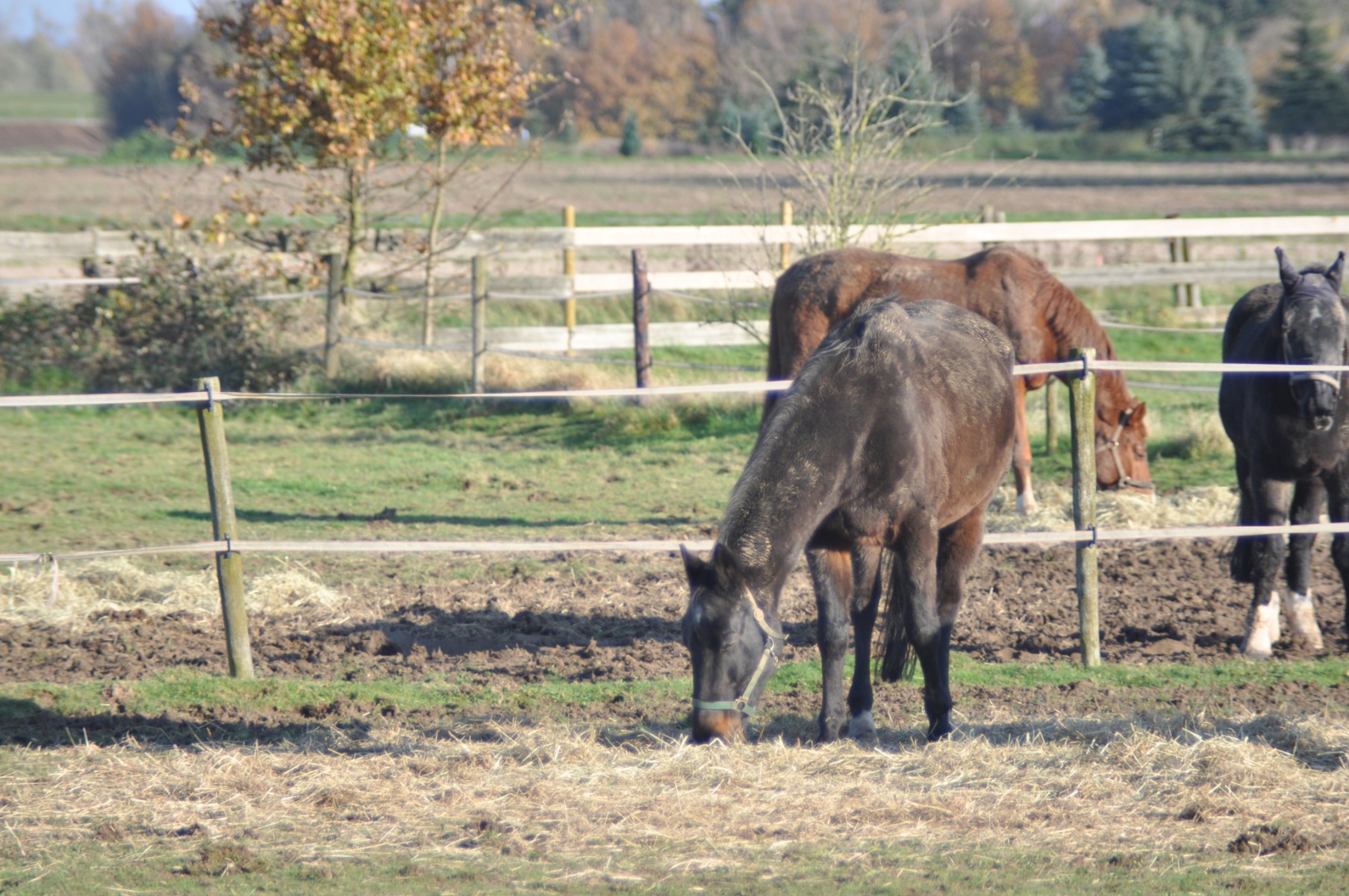
An Ideal Rotational Equine Grazing System
An ideal rotation system for horses has a minimum of four paddocks—all connected by gates—attached to a single, central sacrifice lot. This sacrifice lot is sometimes known as a dry lot or stress lot. It contains shelter and the main feed and water source. Horses always have access to it, no matter what paddock they are grazing.
In this system, the horses always have access to the paddock with the tallest forage. The gate is open to that paddock, and all other entrances are closed. Animals are allowed to graze until they remove about half of the forage, never taking it down between 2 to 3” in height. This is usually 7 to 10 days, depending on the animals.
Once the paddock is sufficiently grazed, the horses are moved to the next paddock ready for grazing, and the gates are shut to the previous. The process continues until all of the paddocks are grazed, and then it begins again.
On average, a single paddock will “rest” for 3 to 4 weeks between rotations.
Stocking Rates for Equine Pastures
The stocking rate is the most important—and commonly ignored—aspect of equine pasture management. The total body weight of horses grazed on an acre of pasture must be within an acceptable range to successfully manage the stand(s).
The general recommendation is 1000 pounds of animal per two acres. For mature, large horses, this means one horse per two acres; with younger horses, two 500-pound animals could graze the same 2 acres.
Looking at Hay Quality Versus Grazing Quality
If you cut or mow forages for later use as hay, there will inherently be some nutritional differences. These differences are primarily because fresh pasture grasses and legumes have a considerably higher water content, affecting other dietary components.
Moisture Content
- Pasture plants typically contain 75 - 90% water
- Hay contains 10 - 12% moisture
The moisture content difference is the leading reason hay can be stored successfully for periods without seeing mold growth. However, with the lower moisture content, you must increase your horse’s water intake when feeding hay.
Crude Protein (CP)
- Grass pastures contain 10 - 20%
- Legume pastures contain 20 - 24% protein
- Grass hays contain 6 - 10%
- Legume hays contain 12 - 20%
As you can see, fresh pasture forages typically have higher crude protein levels than hay, and the overall quality generally is better.
After forages are harvested, their proteins undergo proteolysis, breaking down into nonprotein nitrogen-based compounds like ammonia and urea. This breakdown reduces the CP and changes the amino acid profile of hay.
It’s important to note the crude protein of legume and grass pastures also declines as the season progresses and plants mature.
Fiber and Digestibility
- Early pasture forages have better digestibility than mature plants
- Fresh pasture is more digestible than hay harvested at the same time
These digestibility differences are inversely related to fiber content. Lignin, cellulose, and hemicellulose increase as plants age, making them harder to digest.
Vitamin Levels
- Pasture is higher in vitamins A, C, and E levels than hay.
After a forage is harvested, exposure to oxygen and sunlight leads to the degradation of these essential nutrients. During hay storage, this degradation continues, leading to significantly lower vitamin levels than fresh forages.
Non-Structural Carbohydrates (NSC)
- Pasture typically has 15% NSC
- Hay typically has about 11% NSC
Once harvested, forage plants continue respiration until the moisture levels are much lower and the material is dried. They use a significant amount of non-structural carbohydrates (NSC) during respiration.
Deer Creek Seed Can Help With Your Equine Forage Needs
Whether you need help choosing between grass or legume forages or picking the best seeds for your equine forage needs, look no further than Deer Creek Seed! Our high-quality seeds grow productive, nutritious pasture forages, and our experts are here to answer any questions about seed selection or crop management.
Deer Creek Seed’s purpose is to provide you with the highest quality seed at competitive prices and exceptional customer service. Our staff works diligently to serve our customers!
Additional Resources
- The University of Minnesota Extension looked at horse preference, yield, and species persistence of cool-season grass mixtures under Midwest grazing conditions. This is a helpful resource if you’re interested in mixed grass forages.
- Interested in using Bermudagrass for horse forage? The University of Kentucky designed an experimental Bermuda pasture at their Spindletop Farm in the spring of 2003.
- Crabgrass seems like an unlikely choice as a pasture grass, but Rutgers University researchers have shown the weed’s strengths make it a great choice for summer forage. https://ker.com/equinews/researchers-eye-crabgrass-as-a-pasture-plant-for-horses/
- Rotational grazing doesn’t have to be confusing with this helpful guide from Iowa State University’s Extension and Outreach.
- Need help to understand your horse’s forage report? The UGA Forage Extension Team walks you through moisture, protein, carbohydrates, nutrients, and energy value.
- Deer Creek Seed takes the guesswork out of determining how and when to harvest your forages for hay or silage.



